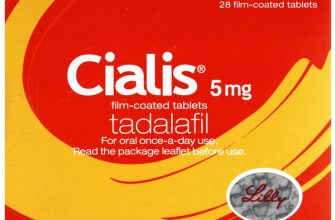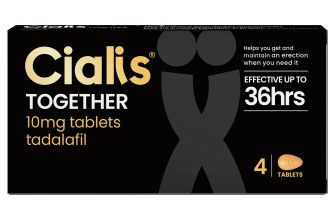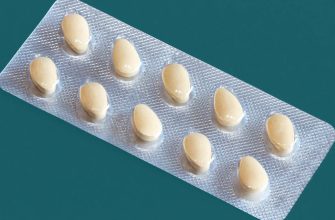Considering Cialis for erectile dysfunction (ED) and benign prostatic hyperplasia (BPH)? This medication offers a dual action, addressing both conditions simultaneously. Its unique mechanism helps relax muscles in the prostate and blood vessels, leading to improved urinary flow and firmer erections.
Cialis, unlike some other treatments, provides a longer duration of action–up to 36 hours. This extended effect offers more spontaneity and flexibility in sexual activity. However, remember that individual responses vary, and consulting a doctor is paramount before starting any medication.
Important Note: Before beginning Cialis, discuss your medical history, including any existing conditions and medications you’re currently taking, with your physician. They can assess your suitability for Cialis and help determine the appropriate dosage to manage both ED and BPH effectively. They can also discuss potential side effects and answer any questions you may have.
Dosage: Your doctor will prescribe the correct dosage based on your individual needs and response. Common dosages range from 2.5mg to 20mg daily, but this is subject to change based on your health profile and the severity of your conditions. Follow your doctor’s instructions precisely.
Regular check-ups with your doctor are recommended while taking Cialis, particularly to monitor blood pressure and assess the treatment’s efficacy. Open communication with your healthcare provider ensures safe and optimal management of your health concerns.
- Cialis for ED and BPH: A Comprehensive Guide
- Understanding Erectile Dysfunction (ED) and Benign Prostatic Hyperplasia (BPH)
- ED Causes and Risk Factors
- BPH Causes and Risk Factors
- The Connection Between ED and BPH
- Treatment Options
- Comparison of ED and BPH Symptoms
- Seeking Professional Help
- How Cialis Works to Treat ED and BPH
- Cialis Dosage and Administration for ED and BPH
- Dosage for BPH
- Potential Side Effects and Precautions When Taking Cialis
- Comparing Cialis to Other ED and BPH Treatments
- Erectile Dysfunction (ED) Treatments:
- Benign Prostatic Hyperplasia (BPH) Treatments:
- When to Consult a Doctor About Cialis for ED and BPH
Cialis for ED and BPH: A Comprehensive Guide
Cialis treats both erectile dysfunction (ED) and benign prostatic hyperplasia (BPH) by relaxing muscles in the prostate and bladder, improving blood flow. This dual action makes it a convenient option for men experiencing both conditions.
The recommended starting dose for ED is typically 10mg, taken as needed, at least 30 minutes before sexual activity. For BPH, a daily 5mg dose is usually prescribed. Your doctor will determine the best dosage based on your individual needs and health status. Always follow your doctor’s instructions.
While Cialis generally shows good tolerance, potential side effects include headache, flushing, nasal congestion, and muscle aches. More serious, though rare, side effects include sudden vision loss or hearing loss. Seek immediate medical attention if these occur.
Cialis interacts with certain medications, notably nitrates used for heart conditions. Combining them can cause a dangerous drop in blood pressure. Inform your doctor about all medications you are taking, including over-the-counter drugs and supplements.
Regular monitoring is crucial. Your doctor will likely want to check your blood pressure and prostate health periodically while on Cialis. Open communication with your doctor about any concerns or changes in your health is critical for safe and effective treatment.
Before starting Cialis, discuss your medical history, including heart problems, liver or kidney disease, and eye conditions. This allows for a tailored treatment plan minimizing potential risks. Cialis may not be suitable for everyone.
Remember, this information is for educational purposes only and does not constitute medical advice. Always consult your doctor before starting any new medication, including Cialis, to ensure its safety and suitability for your individual circumstances.
Understanding Erectile Dysfunction (ED) and Benign Prostatic Hyperplasia (BPH)
Erectile dysfunction (ED) and benign prostatic hyperplasia (BPH) frequently coexist, affecting many men over 50. ED involves the inability to achieve or maintain an erection firm enough for satisfactory sexual intercourse. BPH, on the other hand, refers to an enlarged prostate gland, often causing urinary symptoms like frequent urination, weak urine stream, and nighttime urination.
ED Causes and Risk Factors
Several factors contribute to ED. These include aging, certain medications (like blood pressure drugs), underlying health conditions (such as diabetes and heart disease), and psychological factors like stress and anxiety. Lifestyle choices, such as smoking and lack of exercise, also play a role.
BPH Causes and Risk Factors
BPH is largely age-related, with the risk increasing significantly after age 50. Hormonal changes contribute to prostate growth, although the exact mechanisms remain unclear. Family history of BPH increases risk. While not directly causing ED, BPH’s treatments can sometimes have side effects that contribute to ED.
The Connection Between ED and BPH
The link between ED and BPH is multifaceted. An enlarged prostate can sometimes compress the urethra and affect nerves controlling erections. Moreover, medications for BPH, particularly alpha-blockers, can sometimes lead to ED as a side effect. Both conditions often share similar risk factors, like age and underlying health issues.
Treatment Options
Treatment options for both conditions vary. ED treatments include oral medications like Cialis, phosphodiesterase-5 inhibitors, and injections. BPH treatment may involve medication to relax the prostate and improve urine flow, or minimally invasive procedures. Your doctor will determine the best course of action based on your individual needs and health status.
Comparison of ED and BPH Symptoms
| Symptom | Erectile Dysfunction (ED) | Benign Prostatic Hyperplasia (BPH) |
|---|---|---|
| Difficulty achieving or maintaining an erection | Yes | No |
| Frequent urination | No | Yes |
| Weak urine stream | No | Yes |
| Nocturia (nighttime urination) | No | Yes |
| Painful urination | No | Possibly |
Seeking Professional Help
If you experience symptoms of ED or BPH, consult a healthcare professional. Early diagnosis and treatment can improve your quality of life and address potential complications. Open communication with your doctor is crucial for effective management.
How Cialis Works to Treat ED and BPH
Cialis treats erectile dysfunction (ED) by increasing blood flow to the penis. It does this by inhibiting phosphodiesterase-5 (PDE5), an enzyme that breaks down cyclic guanosine monophosphate (cGMP). Higher cGMP levels relax blood vessels, allowing for improved blood flow and facilitating an erection.
For benign prostatic hyperplasia (BPH), Cialis’s mechanism is slightly different. It relaxes the muscles in the prostate and bladder neck, reducing urinary obstruction and improving urine flow. This relaxation effect stems from the same PDE5 inhibition, but it acts on different muscle groups compared to its ED treatment mechanism.
The dosage for ED and BPH might vary. Your doctor will determine the appropriate dose based on your individual needs and health status. Always follow your doctor’s instructions carefully.
Remember, Cialis is a prescription medication. Consult your physician before starting any new medication, especially if you have underlying health conditions or are taking other medications. They can assess your suitability for Cialis and manage potential interactions.
While Cialis can significantly improve symptoms for both ED and BPH, it’s not a cure. Regular follow-up appointments with your doctor are vital for monitoring your progress and making any necessary adjustments to your treatment plan.
Cialis Dosage and Administration for ED and BPH
For erectile dysfunction (ED), the typical starting dose is 10 mg, taken as needed, at least 30 minutes before sexual activity. Some men may find 5 mg sufficient, while others may require 20 mg. Your doctor will determine the appropriate dose based on your individual needs and response. Never exceed the recommended maximum daily dose of 20 mg.
Dosage for BPH
For benign prostatic hyperplasia (BPH), the usual dose is 5 mg once daily, taken at the same time each day. This consistent dosing helps maintain consistent levels of the medication in your system for sustained symptom relief. Your doctor might adjust this dose depending on your response. This dose is lower than that typically used for ED, as the goals are different. You should continue taking Cialis daily, even if you don’t experience immediate improvement. Results typically take several weeks to become fully apparent.
Remember to discuss any potential side effects or concerns with your doctor. They can help you manage any adverse reactions and adjust your dosage accordingly. Follow your doctor’s instructions carefully.
Potential Side Effects and Precautions When Taking Cialis
Cialis, while generally safe and effective, can cause side effects. Headache is common, often mild and temporary. Muscle aches and back pain may also occur. Some men experience nasal congestion or flushing. Less frequently, you might see indigestion or dizziness.
More serious, though rare, side effects include sudden vision loss or hearing loss. Seek immediate medical attention if you experience either. Prolonged erection (priapism) is another serious side effect requiring prompt medical help. This condition necessitates immediate action to prevent permanent damage.
Before starting Cialis, discuss your medical history with your doctor. This includes any heart conditions, liver or kidney problems, blood pressure issues, or history of stroke. If you use nitrates for chest pain, Cialis is contraindicated due to the risk of dangerously low blood pressure. Inform your doctor about all medications you are currently taking, including over-the-counter drugs and supplements, to avoid potential drug interactions.
Alcohol consumption can increase the risk of side effects. Limit your alcohol intake while taking Cialis. Grapefruit juice can also interact with the medication, so avoid it. Follow your doctor’s instructions carefully regarding dosage and frequency. Never exceed the recommended dose.
Cialis may affect your ability to drive or operate machinery, especially if you experience dizziness or vision changes. Exercise caution until you know how the medication affects you. Regular monitoring of your blood pressure is advisable, especially if you have pre-existing hypertension. Remember to discuss any concerns you have with your physician.
Comparing Cialis to Other ED and BPH Treatments
Choosing the right treatment depends on individual needs and preferences. Let’s compare Cialis with other common options.
Erectile Dysfunction (ED) Treatments:
- Viagra (sildenafil): Acts faster than Cialis, but its effects are shorter-lasting. Consider Viagra if you need quicker onset of action.
- Levitra (vardenafil): Similar to Viagra in onset and duration, but may be a better option for some with specific health conditions. Consult your doctor for personalized advice.
- Avanafil: Offers a relatively quick onset of action, comparable to Viagra. It might be suitable for those seeking rapid results.
- Injection Therapy: Involves injecting medication directly into the penis. This method is used less frequently due to potential discomfort and side effects. Discuss this option with your doctor if other treatments haven’t worked.
- Vacuum Erection Devices: These devices create a vacuum to help achieve an erection. They can be used alone or in combination with other therapies. They are generally considered less invasive.
- Penile Implants: A surgical option providing long-term solutions. This is usually considered after other methods have failed.
Benign Prostatic Hyperplasia (BPH) Treatments:
- Alpha-blockers (e.g., Tamsulosin): These relax the muscles in the prostate and bladder neck, improving urine flow. They don’t address ED directly.
- 5-alpha reductase inhibitors (e.g., Finasteride): Shrink the prostate over time. These are typically prescribed for larger prostates and may take several months to show noticeable improvement. They don’t treat ED.
- Combination therapy: Combining an alpha-blocker and a 5-alpha reductase inhibitor is often used to manage BPH symptoms effectively.
- Surgical options (e.g., TURP, laser surgery): Surgical interventions are considered when medication proves ineffective. These options aim to remove or reduce the size of the prostate.
Cialis’s dual action makes it a convenient option for men with both ED and BPH. However, the best treatment will depend on your specific condition and medical history. Always consult your doctor to determine the most appropriate treatment plan for you.
When to Consult a Doctor About Cialis for ED and BPH
Schedule an appointment if you experience chest pain, irregular heartbeat, or sudden vision changes while taking Cialis. These are serious side effects requiring immediate medical attention.
Consult your doctor before starting Cialis if you have a history of heart problems, low blood pressure, or stroke. He or she can assess your suitability for the medication.
Discuss any other medications you’re taking with your doctor. Cialis can interact with some drugs, potentially leading to adverse effects.
If Cialis isn’t improving your ED or BPH symptoms after several weeks, contact your doctor. They may adjust your dosage or recommend alternative treatments.
Report any persistent side effects, such as headaches, muscle aches, or nasal congestion, to your doctor. They can help manage these issues or suggest alternative options.
If you experience a sudden decrease or loss of hearing, seek medical advice immediately. This is a rare but serious side effect.
Regular check-ups with your doctor while using Cialis are recommended, especially if you have underlying health conditions. This allows for ongoing monitoring and adjustment of treatment as needed.







